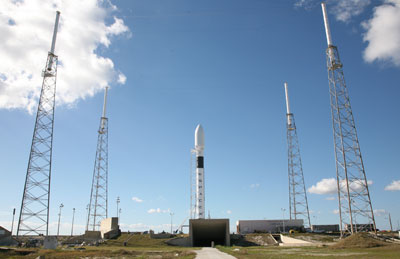Augustine’s questionable adjectiveby Taylor Dinerman
|
| If this part of the space industry is thrown into the deep water before it is ready, then not only will this hurt, or maybe even bankrupt, some of these firms, but this might destroy the whole space exploration program before it has the chance to get out of LEO. |
What may be the most misleading part of the report is the description of the NewSpace industry. In the executive summary they write, “Second, there is now a burgeoning commercial space industry. If we craft a space architecture to provide opportunities to this industry, there is the potential—not without risk—that the costs to the government would be reduced.” If the industry were really “burgeoning”, it would follow naturally that NASA could afford to hand over the Earth to low Earth orbit (LEO) mission to the new guys now and concentrate on getting out to the Moon, Mars, or wherever. Unfortunately, the new entrants into this area have not taken more than a few baby steps towards their goals.
SpaceX, which is by far the best positioned of these new firms, has so far only launched two of its Falcon 1 rockets. This is impressive, but it is not evidence of any burgeoning new industry. The Falcon 9 launch now planned for February 2010 will, if successful, be a powerful demonstration. The more SpaceX shows that its systems perform as advertised, the more attractive their proposals to provide crew transportation services to the space station become.
The Scaled Composites (wow part of Northrop Grumman) WhiteKnightTwo/SpaceShipTwo combination has not yet made it out of the hangar. Even when it does it will still only have suborbital capability. While this will be useful for science and for technology development, no one expects that this technology will provide a path to orbit for at least a decade, if ever.
Orbital Sciences is not really a NewSpace company. It is more of a traditional aerospace firm with a strong relationship with the Defense Department, although when viewed through the eyes of a former Lockheed Martin CEO, it may resemble a start-up. Their Taurus 2 and Cygnus rocket and capsule combination that will compete with SpaceX, will not have its first launch until February 2011.
On the other end of the scale are a number of small, highly innovative companies such as committee member Jeff Greason’s XCOR Aerospace, based in Mojave, California, currently building the small Lynx suborbital space tourism spaceplane. Also in this category are Masten Space Systems and Armadillo Aerospace, who just won more than a million dollars of NASA Centennial Challenges prize money. These firms are building their expertise and following their visions. As they grow, they will create new opportunities for the space industry and for this nation. It is, however, a slow and difficult process and no one should expect instant results.
| These emerging firms show huge promise, but they are just getting started and the US government should not expect them to perform miracles. |
It is this mismatch between expectations and realistic potential that endangers the whole enterprise. If this part of the space industry is thrown into the deep water before it is ready, then not only will this hurt, or maybe even bankrupt, some of these firms, but this might destroy the whole space exploration program before it has the chance to get out of LEO. If SpaceX and Orbital Sciences were to be given an exclusive contract now to transport US and other crew members to and from the ISS, within the next four or five years they would be performing a high wire act without a net. On balance this is probably a risk worth taking, but it should not be taken blindly.
These firms are hardly the representatives of a burgeoning new industry. What exists is a remarkable tribute to the American entrepreneurial spirit. Taken together they do not yet constitute a thriving, self-supporting industry, capable of generating profits on a year-in, year-out basis. They may be getting there, but not yet.
Historically they are roughly where the commercial aviation industry was in the early 1920s: partly subsidized by governments with air mail contracts, partly surviving by giving joyrides to the public, and partly supported by visionary investors who knew that, one way or another, aviation was going to dominate a large part of the world’s transportation business in the 20th century. That promise was fulfilled, but not until the 1950s and 1960s. Thirty or forty years is a long time to wait for a big payoff.
Industry spokespeople have been realistic about this, but others have shown a tendency to expect too much too soon. I confess that I have made this mistake myself. These emerging firms show huge promise, but they are just getting started and the US government should not expect them to perform miracles. Neither they, nor the big contractors, have access to supplies of magic pixie dust. Plans cannot be made on the basis that they will have such a supply in the future.
